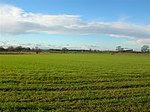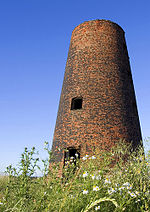Steeton Hall Farm

Steeton Hall Farm is a historic building in the civil parish of Steeton, North Yorkshire, south-west of York in England. Steeton Hall was in existence by the 12th century, when a chapel was built. In about 1474, Guy Fairfax replaced the old hall with a large manor house, with a moat. In the 1558, his descendent, William Fairfax, made an inventory of the property, which had nine bedrooms, two studies, a hall and a parlour. In the early 18th century, the building was reduced in size, with the demolition of its wings, and the building later became a farmhouse. The chapel was converted into a granary, and demolished in 1873. The house was Grade II* listed in 1985.The building is constructed of Magnesian Limestone, with a slate and pantile roof, and brick chimneys. There is also a brick extension, dating from the 20th century. The house is two storeys high, and has seven first floor windows, with the entrance door under the sixth window. The doorway has a Tudor arch, and the door is panelled. Most of the windows have mullion and transoms, and inside some boxed timber beams are visible.Outside the house, there is a 20-metre wall, built in the 15th century of Magnesian Limestone, which originally formed part of a range of buildings. It incorporates a 12th-century archway, which was the entrance to the chapel. This structure is Grade II listed. Part of the moat also survives, as a ditch.
Excerpt from the Wikipedia article Steeton Hall Farm (License: CC BY-SA 3.0, Authors, Images).Steeton Hall Farm
Steeton Lane,
Geographical coordinates (GPS) Address Nearby Places Show on map
Geographical coordinates (GPS)
| Latitude | Longitude |
|---|---|
| N 53.8916 ° | E -1.1904 ° |
Address
Steeton Hall
Steeton Lane
LS24 8EN , Steeton
England, United Kingdom
Open on Google Maps











